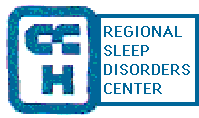-The control of breathing during sleep differs from that during full wakefulness. When we inhale, we take in oxygen, and when we exhale, we breathe out carbon dioxide which is a waste product of our body's metabolism. During sleep, especially non-REM sleep, even minor increases in the carbon dioxide levels in our blood stimulate us to take another breath. In similar fashion, even small decreases in blood carbon dioxide levels (which can result from our breathing more deeply or rapidly) will result in pauses in breathing (central apneas).
-when we first doze off, it is normal to experience brief pauses in breathing. Once we are soundly asleep, breathing tends to stabilize and become regular.
-if patients are unduly arousable, each of these normal pauses in breathing may trigger an arousal or brief awakening with a sudden, transient increase in breathing that drops carbon dioxide levels--which then results in another pause in breathing as the patient begins to doze off again, which in turn triggers yet another arousal...and so on.
This phenomenon is reminiscent of a "slipping clutch". If afflicted patients could simply get into a sound sleep, their breathing would stabilize and become regular, but they "can't get there".
-Obviously, anything that triggers arousals or awakenings in such patients might result in their "getting stuck" in this frustrating cycle of dozing and arousing.
-Some specific circumstances that can precipitate the triggering of CSAs via this basic mechanism:
1. TREATMENT OF OBSTRUCTIVE SLEEP APNEA WITH CPAP OR BILEVEL PAP ("BIPAP").
This is a MAJOR CAUSE OF CSA that recently was termed "COMPLEX SLEEP APNEA" (the emergence of central apneas promptly upon institution of treatment of obstructive sleep apnea with positive airway pressure).
THIS PROBLEM CAUSES MANY PATIENTS WITH OBSTRUCTIVE SLEEP APNEA TO ABANDON TREATMENT...unless something is done to address their central sleep apneas.
WHY? Because patients with complex sleep apnea cannot achieve and maintain sound sleep when using CPAP or bilevel PAP. They find that they either cannot fall into a sound sleep when using their equipment, or that their sleep is light and fragmented by arousals.
WHAT ARE OTHER CLUES THAT CENTRAL APNEAS MAY BE INTERFERING WITH POSITIVE AIRWAY PRESSURE TREATMENT?
--In some but not all cases, bed partners observe that the patients are having pauses in breathing, even though all snoring may have been eliminated.
--Some (but not all) patients awaken with feelings of breathlessness or with gasping.
--Some note that they do not feel as well during the day as they expected.
I HAVE ALWAYS FELT THAT IT IS CRUCIAL TO DEAL WITH THIS PROBLEM OF CENTRAL APNEAS THAT EMERGE WHEN POSITIVE AIRWAY PRESSURE IS FIRST STARTED. I find it vital to ensure that patients are able to sleep comfortably through the night with their equipment in place. Attention to every detail is extremely important. Otherwise, sleep apnea victims will never be able to get used to using positive airway pressure, such that they will either abandon treatment entirely or turn to therapeutic alternatives with much lower success rates. I suspect that the fact that many sleep centers do not treat central apneas may help explain why national CPAP compliance rates are so low.
HOW CAN ONE TREAT THE PROBLEM OF CENTRAL SLEEP APNEAS RESULTING FROM INSTITUTION OF CPAP OR BILEVEL PAP? Until now, the options were limited and not predictably helpful. Fortunately, a better answer has just emerged.
--- USE OF BILEVEL PAP WITH A "BACK-UP RATE" (INTERMITTENT MANDATORY VENTILATION OR IMV). These units sense when patients fail to initiate breathing and then respond with delivery of bursts of air at pre-set rates and pressure levels, much like a demand ventilator by way of the nose. However, they often were poorly tolerated by patients who would report inability to synchronize their breathing with the machine, and the less than subtle way that they would intervene at the time of breathing pauses would often trigger arousals and set up a cycle of repeated central apneas--thereby making the problem even worse.
---DELIVERY OF SUPPLEMENTAL OXYGEN VIA THE CPAP OR BILEVEL PAP UNIT. This strategy sometimes stabilizes breathing but not in many cases. Also, oxygen therapy has its own problems. Oxygen concentrators are heavy and not travel friendly. Their ongoing rental is very expensive. They also are frequently noisy and many of them generate heat: both of which can worsen the sleep of patients and their bed partners alike!
---ADAPTIVE SERVO-VENTILATION (ASV). Here is the good news! At last, a treatment has been developed that is far more comfortable than bilevel PAP with IMV, that is virtually always effective and that typically renders use of supplemental oxygen unnecessary. Click here for more information on this important breakthrough in sleep medicine: adaptive servo-ventilation (ASV).
2. PERIODIC LIMB MOVEMENT SYNDROME. As described elsewhere on The Sleep Site, this common syndrome involves repeated jerks in the lower extremities--and in some cases, in the arms. It usually does not cause symptoms--such that treatment is often unnecessary. However, in patients prone to central sleep apnea, repeated arousals triggered by PLMS may result in precipitation of repeated pauses in breathing that then may perpetuate themselves, as the patient experiences inability to return to sound sleep.
3. ANY OTHER FACTORS--WHETHER INHERENT IN THE PATIENT OR ENVIRONMENTAL, SUCH AS NOISE, can trigger the onset of repeated central apneas in predisposed patients.

